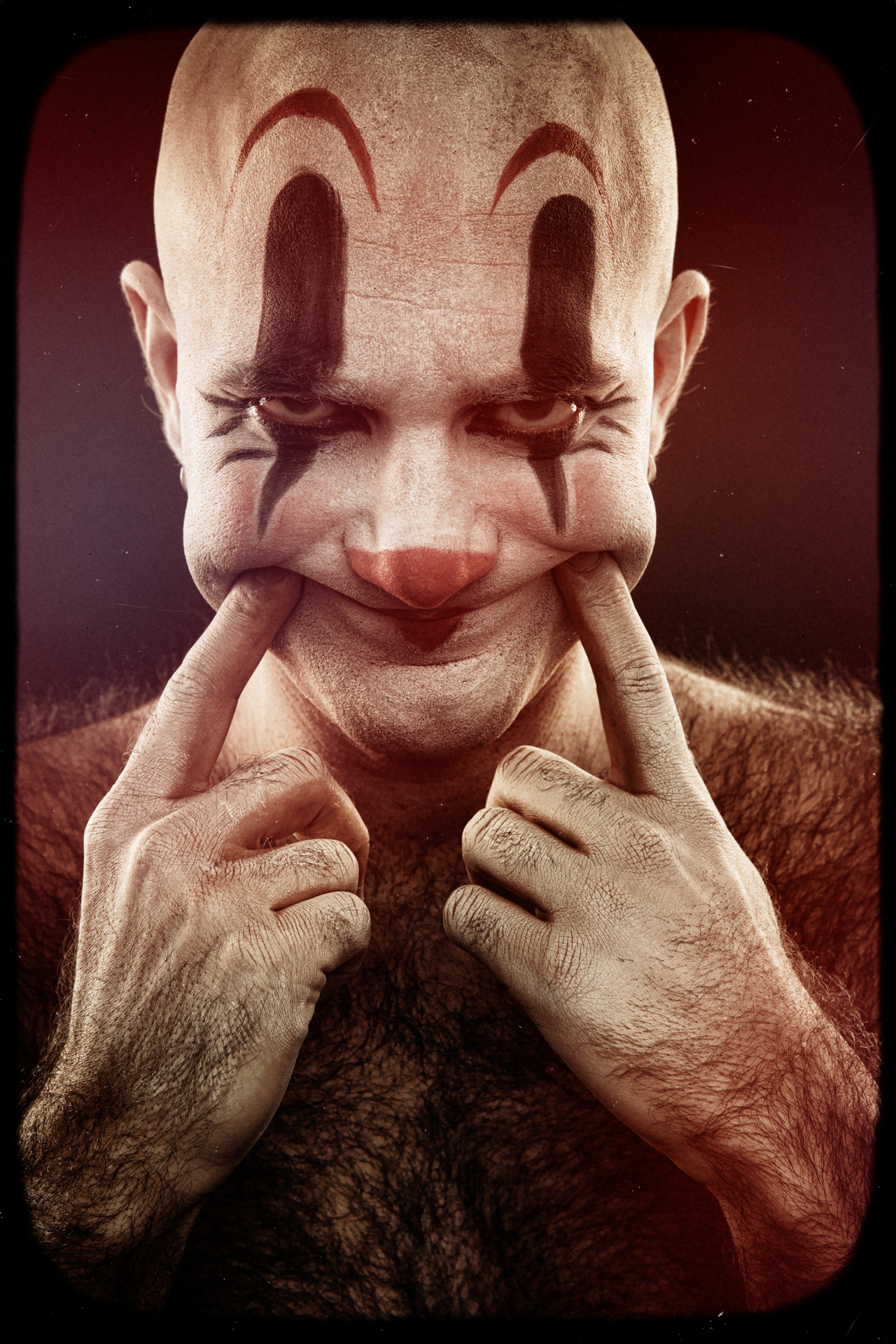Last Updated on 05/17/2019 by Mark Beckenbach
All images by Eolo Perfido. Used with permission.
“The first instrument of the portraitist is not the light, or the lens, or the camera,” explains Eolo Perfido. “It’s the subject.” The French-born, Italian photographer is a deeply thoughtful creator. His series, Clownville, offers a dose of innovation, a slice of controversy, and a generous handful of compelling concepts. Whether you’re amused or afraid of clowns, he has brought art to life that you won’t be able to look away from. For him, the series is not just an example of the creative mind; it’s a metaphor of life. The work shows a person prepared to push boundaries. It may shock or it may delight. What is for certain, however, is that it will grab your attention.
Phoblographer: Clownville – where did this wonderfully creative (and slightly scary) concept come from?

EP: My work as a portraitist often leads me to experiment and to understand how to return in the most sincere way the people I have in front of me. However, sometimes I may turn them into something else.
I have always loved the melancholy stories and the clowns seem to be worthy representatives of this vein. So I decided to dedicate a photographic series to this figure, asking people I loved the expressive talent to pose for me.
“Art is a conversation. It must generate emotions. Positive or negative.”
Initially, I thought the mask would hide the character and personality of the people I photographed. They would be transformed into actors ready to interpret the character assigned to them. And instead, to my incredible surprise, I discovered that the mask freed the instincts of the people. This made them give me madness and a performance that was, in fact, their true nature, thanks to that mystery that is the mask. That’s why I feel that Clownville is one of my most significant pieces of portrait work.
Phoblographer: How involved were you in clothes and makeup? Did you have any input in that or was there an MUA and wardrobe assistant on set?

EP: The makeup is the work of Valeria Orlando a clever and creative makeup artist. She gave a great deal to this series with her insights and art. Normally I deal with the initial concept and then discuss it with Valeria and my small team at work. Then everyone takes care of finding the clothes, the location and the visual references. It is not a linear process whereby each session of Clownville is a story to itself.
Phoblographer: In terms of planning the project right through to completion, how long did it take to finish?
EP: Generally from one to two weeks.

Phoblographer: In the series is a cross-dressing, Adolf Hitler clown, giving the Nazi salute. How did this idea come to life and were you worried it may bring some controversy?

EP: Art is a conversation. It must generate emotions. Positive or negative. It aims to generate, if possible, a confrontation between different visions of the concept of beauty and of the world around us. My grandfather was interned in Auschwitz and was among the very few lucky ones who were rescued. Let’s say we have a family bond with the matter. I don’t see anything wrong with representing it in a different way. It’s not meant to scandalize.
“I think that the Circus world and the clown’s world in particular is like a metaphor of our own society…”
There are people who have found “Mein Klown” annoying because they are sympathizers. Others found it trivial. Someone was offended because he saw in the homosexual attitude a judgement of merit. None of them, in my opinion, understood my goal. But I’m not in a hurry to be understood. Like any creative, I feed on others positive constructive comments or criticism.
Phoblographer: With Clownville, what reaction and feeling did you want to evoke from those who viewed the series?

EP: I think that the Circus world and the clown’s world in particular is like a metaphor of our own society: an “interconnected” world in which everybody wants to entertain and be entertained, behind which great sadness and loneliness are hidden. I think the image of the Clown well represents people of today’s society: the hysteria of wanting to please at all costs. It’s sad like wearing a mask that is tragic, grotesque and ambiguous at the same time.
Phoblographer: Because your concepts are so detailed, what kind of mindset do you need to have to get creative and what helps you get there?

EP: I love details. You start with a rough sketch then I start to add small details and I slowly grow the concept. Sometimes it is about getting inspired by other media like movies, illustration or paintings. But it is not just a question of creativity but also of a certain pragmatism. The ability to know how to convey intuitions through a path that is also organization, ability to collaborate and use technique.

Phoblographer: Your post-production studio is extremely impressive. Can you tell us how long it took you to build it up and is there anything you feel you’re missing, or are you happy with where it’s at?

EP: After having worked with Fabio Timpanaro for several years, I decided to create a spin-off of my post-production studio with him. Thus was born Storm Studio which sees Me, Fabio and Antonella Catanese as founding members. Now we would love to increase our team. So we are looking for 3D Artist that works with software like Blender or Cinema 4D.
Phoblographer: Finally, what’s next in your creative world of photography?
EP: Continue to experiment. Probably some of these studies will become new photographic series. In the meantime continue to grow my studio, dedicating myself to advertising, editorial and street photography.



You learn more of Eolo’s work and studio by visiting Eolo Perfido, Storm Studio and Walking Photographer.


